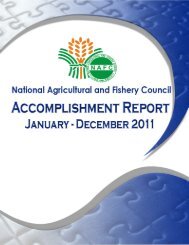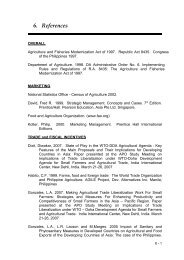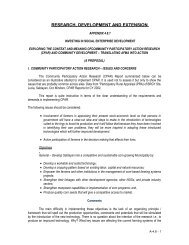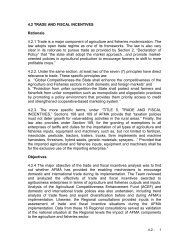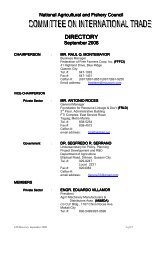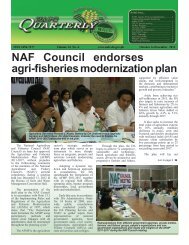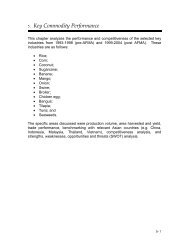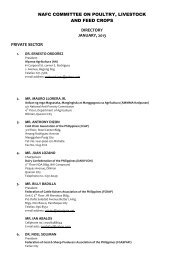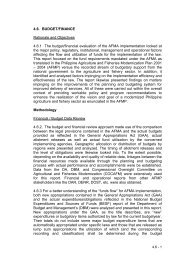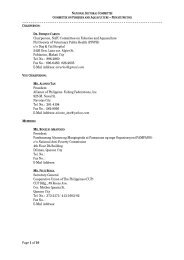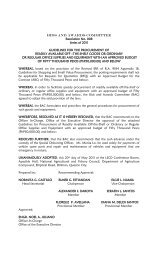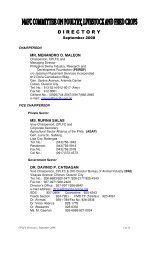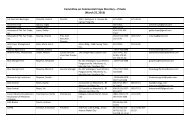EXECUTIVE SUMMARY - National Agricultural and Fishery Council ...
EXECUTIVE SUMMARY - National Agricultural and Fishery Council ...
EXECUTIVE SUMMARY - National Agricultural and Fishery Council ...
Create successful ePaper yourself
Turn your PDF publications into a flip-book with our unique Google optimized e-Paper software.
CHAPTER 4. AFMA COMPONENTS<br />
28. This chapter covered a review of the nine plus two additional AFMA<br />
components.<br />
4.1 Marketing <strong>and</strong> Information<br />
29. Agriculture <strong>and</strong> fish marketing faces many challenges along their<br />
supply/value chains. The dominance of unorganized, dispersed <strong>and</strong> small<br />
producers is a key factor. Unorganized producers affect scale <strong>and</strong> result in<br />
high cost, uneven quality <strong>and</strong> poor supply responsiveness, <strong>and</strong> limited<br />
access to timely information. There is also the high supply chain cost due<br />
to transport costs, assembly costs, <strong>and</strong> quantity/quality losses.<br />
30. Globalization provides many marketing opportunities as well as<br />
challenges. Market size <strong>and</strong> segments are far bigger <strong>and</strong> the buying<br />
power of the consumers is much higher in the foreign markets. But<br />
markets are also more competitive as trade barriers are lower. At the<br />
same time imports have increasingly encroached into the domestic<br />
market. Under this liberal regime, producers must be organized across<br />
the supply/value chain keeping in mind cost, quality, reliability <strong>and</strong><br />
responsiveness, <strong>and</strong> product innovation.<br />
31. At the same time, technical barriers to trade continue to hobble export<br />
trade. Some countries have now more stringent minimum levels <strong>and</strong><br />
minimum residue levels. The lack of agreement under the WTO Doha<br />
Round is a “missed” opportunity as the parties failed to agree on: reduction<br />
of subsidies in developed countries; tariff reduction; <strong>and</strong> non-agriculture<br />
market access.<br />
32. The role of the government, particularly the DA, LGU <strong>and</strong> the Legislature<br />
is to provide the enabling environment for producers (including small<br />
farmers <strong>and</strong> fisherfolk) <strong>and</strong> investors in the supply chain. Investment is<br />
the driver of economic growth <strong>and</strong> job creation. Without investment in<br />
agriculture <strong>and</strong> fisheries, stagnation <strong>and</strong> rural poverty will be exacerbated.<br />
Government must focus on what it can do best: making the goods <strong>and</strong><br />
information highway efficient, freeing the l<strong>and</strong> market, enhancing security,<br />
<strong>and</strong> improving resource use. The private firms know the market better <strong>and</strong><br />
have comparative advantage in choosing the right investment.<br />
The Philippine Farm Sector<br />
33. The Philippine farm sector is dominated by small holdings. In 2002, there<br />
were 4.82 million (M) farms covering 9.67 M hectares (ha), with average<br />
size of only 2 ha. Some 40 percent of the farms were less than 1 ha (with<br />
8.6 percent of area), 41 percent of farms were 1 ha <strong>and</strong> below 3 ha (31<br />
xxviii



